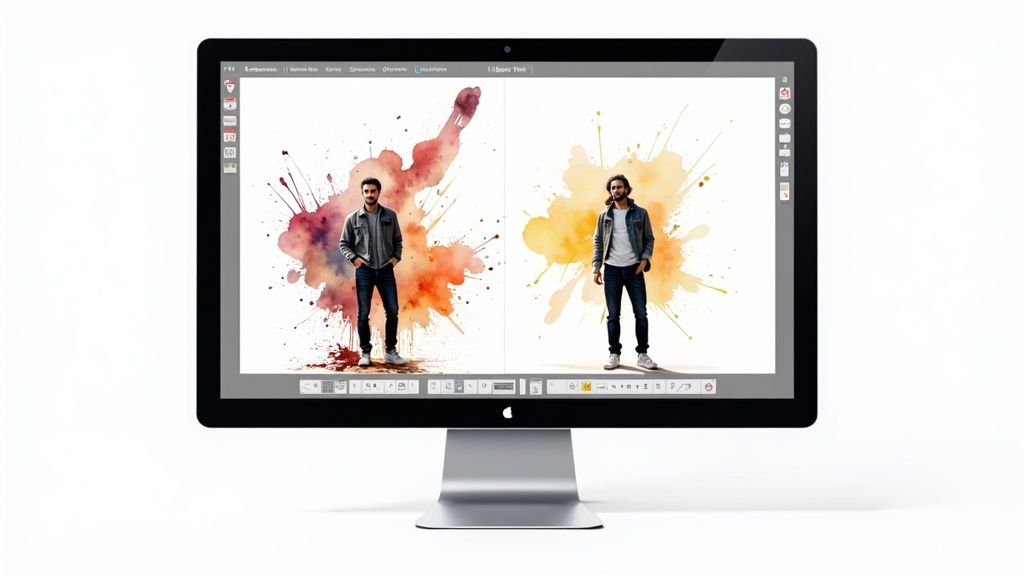How to Make a Transparent Video: Expert Tips & Tricks
Learn how to make a transparent video with our step-by-step guide. Create stunning overlays and effects that captivate your audience.
The Magic Behind Transparent Videos

Creating transparent videos is a fascinating technique that's changing how we approach content creation. Understanding the underlying mechanics of these videos is the first step toward mastering their use. This foundational knowledge will serve you well as you develop practical skills throughout this guide.
Understanding Alpha Channels
The key to transparent videos lies in the concept of alpha channels. Imagine a standard video as a painting made of red, green, and blue (RGB) light. An alpha channel introduces a fourth dimension: transparency. This additional layer acts as an invisible mask, determining how much of the background is visible through each part of your video.
For instance, picture a flickering candle flame. An alpha channel allows you to isolate the flame, making it visible while the surrounding area remains transparent. This enables you to seamlessly overlay the flame onto any other video or image background.
RGB vs. RGBA: A Key Difference
This leads us to a critical distinction between RGB and RGBA videos. Standard RGB videos contain only color information, rendering them opaque. RGBA videos, on the other hand, include the essential alpha channel, which makes transparency possible. To create a transparent video, you must work with the RGBA format.
Creating RGBA videos often requires more advanced techniques. Manipulating the alpha channel is essential for creating professional-quality transparency effects and is commonly used in visual effects (VFX). This allows transparent elements to blend seamlessly with the background. In professional filmmaking, alpha channels are a cornerstone of post-production VFX work.
The challenge traditionally lies in the efficient creation of RGBA videos. New techniques like the TransPixeler method aim to address this by extending pre-trained video models for RGBA video generation. You can explore this further here.
Real-World Applications of Transparent Videos
Transparent videos have a wide range of applications. They are used to create compelling social media content, enabling creators to overlay graphics and animations onto live-action footage. Broadcast overlays, such as the graphics seen on news channels and sporting events, often rely on transparency.
From lower thirds displaying information to animated logos, transparency is the unseen force behind much of the professional content we consume every day. The potential goes even further. Imagine incorporating transparent product shots into promotional materials or developing interactive educational videos with overlayed information. Mastering transparent videos unlocks a wealth of creative possibilities.
Choosing Your Transparency Toolkit

Now that you have a grasp of transparent videos, let's look at the software that makes them possible. Choosing the right tools is key for a smooth video creation process. This section will explore the available options, from professional software to budget-friendly choices, highlighting their strengths and weaknesses for creating transparent videos.
Professional Powerhouses
For high-end work, Adobe After Effects offers robust features for creating and manipulating alpha channels. Adobe After Effects boasts advanced compositing capabilities and precise keyframing, allowing for intricate transparency effects. This power comes at a cost, both financially with a subscription fee and in terms of the time investment needed to learn the software. Beginners may initially feel overwhelmed by the extensive features.
Another premium option is Foundry Nuke, known for its node-based workflow. Foundry Nuke offers immense flexibility for complex transparency projects. Similar to After Effects, Nuke requires a significant investment of both time and money to truly master.
Budget-Friendly Alternatives
Fortunately, there are budget-friendly alternatives with surprisingly good transparency tools. DaVinci Resolve, a free video editing and color grading software, includes features for keying and compositing. DaVinci Resolve provides a solid starting point for creating transparent videos without the hefty price tag, although its features aren't as extensive as After Effects or Nuke. For additional tips, see this helpful resource: How to master video background removal.
Blender, a free and open-source 3D creation suite, also offers compositing features suitable for transparency work. Blender’s node-based compositor, similar to Nuke's, provides a high degree of control. Its versatility extends beyond video editing, making it a valuable tool for various creative projects.
Specialized Transparency Tools
Specific tools cater especially to transparency tasks. SilhouetteFX is a high-end rotoscoping and paint software favored by VFX professionals for creating precise alpha mattes. SilhouetteFX allows for seamless integration of transparent elements, particularly for footage with complex backgrounds.
Background Remover AI is a web-based application offering automated background removal using artificial intelligence. This simplifies the process, especially when absolute precision isn't critical.
To help you choose the right software, we've compiled a comparison table:
Transparent Video Creation Software Comparison: A comprehensive comparison of the most popular software options for creating transparent videos, with details on pricing, features, and difficulty level.
| Software | Price | Platform | Key Features for Transparency | Learning Curve | Export Formats |
|---|---|---|---|---|---|
| Adobe After Effects | Subscription | Windows, macOS | Advanced compositing, keyframing, alpha channel manipulation | Steep | MOV, AVI, MP4, etc. |
| Foundry Nuke | Subscription | Windows, macOS, Linux | Node-based compositing, advanced keying | Very Steep | EXR, DPX, MOV, etc. |
| DaVinci Resolve | Free/Paid | Windows, macOS, Linux | Keying, compositing | Moderate | MOV, MP4, etc. |
| Blender | Free/Open Source | Windows, macOS, Linux | Node-based compositing | Moderate to Steep | MOV, AVI, MP4, etc. |
| SilhouetteFX | Subscription | Windows, macOS, Linux | Rotoscoping, paint, alpha matte creation | Steep | PNG, PSD, etc. |
| Background Remover AI | Varies | Web-based | AI-powered background removal | Easy | MP4, PNG |
This table summarizes the key features, pricing, and learning curve for each software, making it easier to compare them side-by-side.
Choosing The Right Software For You
The best software for you depends on your individual needs and budget. If you need high-end visual effects and have the resources, After Effects or Nuke might be suitable. For those starting out or with tighter budgets, DaVinci Resolve or Blender offer excellent value. Specialized tools like SilhouetteFX or Background Remover AI are valuable for specific transparency challenges.
Consider your project's complexity, your technical skills, and your budget when deciding. Experiment with different options to find what best suits your workflow and creative vision. Creating transparent videos often goes hand-in-hand with mastering the software that enables it.
Creating Your First Transparent Video

Transforming video footage into a transparent video is a multi-step process, from initial planning to the final export. This guide offers a practical overview, highlighting techniques to simplify background removal and transparency creation.
Pre-Production: Setting the Stage for Success
Even before filming, a few pre-production choices can significantly impact your editing time. Your background is the first consideration. A solid, evenly lit backdrop that contrasts with your subject is ideal. A light green or blue screen works well, but even a plain white or black background can streamline the process. This makes isolating your subject during post-production much simpler.
Lighting is also crucial. Even, diffuse lighting minimizes shadows and results in cleaner keying (the process of removing the background). Avoid harsh shadows and hotspots, which can create unwanted artifacts in the final transparent video.
Step-by-Step Transparency Creation
The exact steps for creating a transparent video vary depending on the software you use. However, the general process is consistent:
- Import your footage: Start by importing your video into your chosen editing software.
- Mask or Key Out the Background: This is the core of creating transparency. Use your software's keying or masking tools to isolate the subject. For solid backgrounds, a simple chroma key may be sufficient. More complex backgrounds may require rotoscoping, manually tracing the subject frame by frame.
- Refine the Edges: Closely examine the edges of your subject. Edge refinement tools can smooth out jagged lines or unwanted artifacts. This step is vital for a professional, polished result.
- Adjust Color and Transparency: Fine-tune the color and transparency of your subject to ensure it integrates seamlessly with any new background. Statistical analysis sometimes plays a role in optimizing this process; similar analysis is used to evaluate viewer preferences. For instance, viewer surveys often use a combination of prevalence, precision, and confidence level calculations. Learn more about statistical analysis in video production here.
- Preview and Adjust: Preview your transparent video against various backgrounds to verify it appears correctly. This allows you to identify and correct any errors before exporting.
Handling Common Challenges
Common challenges for beginners include edge artifacts (jagged lines around the subject) and color contamination (background color bleeding onto the subject). These can typically be resolved by refining your key, adjusting lighting in post-production, or using a garbage matte to mask unwanted areas.
Exporting Your Transparent Video
Finally, export your video in a format that supports transparency. WebM with the VP9 codec and ProRes 4444 with an alpha channel are excellent choices. Avoid formats like standard MP4, which don't inherently support transparency.
You might find this resource helpful: 7 Best Video Background Removal Tools for Content Creators. Selecting the right export settings is crucial for ensuring your video displays correctly when uploaded or shared. This includes choosing the correct codec and container format for optimal compatibility. With careful attention to each step, you can create professional-looking transparent videos from ordinary footage, ready for any application.
Pro Techniques That Transform Your Videos

Moving beyond basic video editing, let's explore advanced techniques that can truly distinguish professional transparent videos. These methods, often seen in high-end productions, can add depth and realism, elevating your content to a new level of sophistication.
Mastering Partial Transparency
Fully transparent backgrounds are a common approach, but partial transparency offers a compelling way to introduce depth and visual interest. Imagine a video where your subject is partially see-through, revealing a subtly layered background. This technique can be used for a variety of effects, from creating ghostly apparitions to blending elements artistically or revealing underlying details within a product.
For instance, showcasing the inner workings of a complex machine can be achieved by making its outer casing partially transparent. This adds a layer of visual information and engagement that opaque videos simply can't match.
The Art of Rotoscoping
Automated background removal tools are incredibly useful, but for achieving true precision, rotoscoping remains essential. This technique involves manually tracing the outline of your subject frame by frame in video editing software like Adobe After Effects. It's a time-intensive process, but the payoff is unparalleled accuracy, especially for complex shapes like hair or flowing fabric.
VFX artists frequently rely on rotoscoping for scenes where automated tools struggle, highlighting its critical role in achieving a polished, professional look. This meticulous approach allows the creation of perfectly clean edges and isolation of even the finest details.
Advanced Keying Techniques
Keying, or removing backgrounds, can be particularly challenging with elements like hair and glass. Advanced keying techniques offer solutions to these difficulties, such as using multiple keys or combining keying with rotoscoping.
Imagine using a chroma key for the main subject and then meticulously rotoscoping fine details like individual strands of hair. This combined approach allows for a flawless final result. It ensures a seamless and natural transition between the subject and the new background.
Compositing and Lighting Matching
Creating a believable composite involves more than just background removal. Compositing refers to seamlessly integrating your transparent subject onto a new background. This process requires careful attention to lighting and color.
For example, if your subject is filmed in bright sunlight, but the new background is a dimly lit room, adjustments to the subject's lighting and color are essential for a cohesive look. This key step avoids the artificial "pasted-in" appearance and delivers a realistic final product.
Furthermore, ethical considerations surrounding transparency are becoming increasingly vital, particularly with the rise of AI-generated content. It's important to be mindful of how transparency is used and to ensure viewers can distinguish between real footage and synthetic media. More information about ethical transparency in video production can be found here. By mastering these professional techniques, your transparent videos will achieve a polished look that sets them apart. These advanced methods, while requiring more effort, ultimately result in videos with a quality comparable to high-end productions.
Delivering Flawless Transparent Content
Creating a transparent video is only half the journey. Making sure it displays correctly across various platforms is the real challenge. This section explores the complexities of file formats, platform-specific requirements, and troubleshooting common transparency issues, ensuring your video renders as intended, every time, for every viewer.
The Importance of File Formats
Picking the correct file format is paramount for preserving transparency. Some formats inherently support transparency, while others do not, potentially making all your hard work invisible. WebM, with the VP9 codec, is an excellent option for web use, providing both transparency and efficient compression. ProRes 4444 is a professional-grade format perfect for high-quality productions and editing in applications like Final Cut Pro, especially due to its ability to retain alpha channel information.
However, widely used formats like standard MP4 files don't inherently support transparency. Selecting the wrong format can lead to frustration when a transparent background renders as a solid color after uploading. Understanding these differences is essential for a smooth and effective workflow.
Navigating Platform Requirements
Different platforms have unique requirements for transparent videos. YouTube, for example, supports transparency in certain formats but might require specific encoding settings. Instagram also has its own set of guidelines for transparency and supported file types. Embedding transparent videos on websites often involves specific HTML5 <video> tag attributes to activate alpha channel display.
When uploading to YouTube, for instance, make sure you're using a supported format like WebM and that your encoding settings retain the alpha channel. Overlooking these platform-specific details is a common oversight that can result in losing transparency. Researching each platform's exact requirements is crucial for successful implementation.
Additionally, the growing use of video in B2B marketing demonstrates the potential of transparent videos. With 96% of individuals stating they prefer video to learn about a product or service, and 87% of B2B marketers already using video, incorporating techniques like transparency provides a powerful way to engage audiences and foster trust. More in-depth information can be found here: https://vidico.com/news/b2b-video-marketing-statistics/. This underscores the demand for visually compelling content that can grab attention and communicate information effectively.
Troubleshooting Transparency Problems
One common issue is transparency rendering correctly in editing software but disappearing after upload. This frequently happens due to format incompatibility or incorrect export settings. Double-checking export settings to ensure the alpha channel is preserved is a key first step.
Another problem is inconsistent transparency across browsers or devices. This can occur because of varying levels of support for video codecs or alpha channel handling. Testing your video across various browsers and devices before publishing is always a recommended practice.
Lastly, consider the background against which your video will be displayed. Using a simple white or black background simplifies testing and debugging. A complex background might obscure or unexpectedly interact with your transparent video, making troubleshooting far more difficult.
By understanding these critical aspects of delivering flawless transparent content – file formats, platform compatibility, and troubleshooting – you can ensure your vision is communicated effectively. This guarantees your transparent video displays correctly on all devices, platforms, and browsers.
Innovative Ways to Showcase Transparent Videos
Transparent videos offer a wealth of creative possibilities, moving beyond simple background removal. They are changing how creators connect with audiences and how businesses share information. This section explores the innovative applications of these videos, pushing the boundaries of content creation.
Branding and Overlays for Streamers
Streaming professionals are increasingly incorporating transparent video elements to cultivate distinctive brand identities. Imagine a streamer with a custom animated logo seamlessly integrated with their live gameplay. This fosters instant recognition and a consistent visual theme. Transparent lower thirds displaying social media handles or donation links offer crucial information without disrupting the main action. These subtle yet effective uses of transparency elevate the viewer experience and strengthen brand presence. You might be interested in: How to master content creation.
Dynamic Presentations
Traditional slideshow presentations can often feel static and uninspired. Transparent videos offer a way to revitalize them. Overlaying transparent video clips onto slides adds dynamic visuals that better illustrate key concepts. For example, imagine showcasing product features with a transparent product demonstration video playing over the slide text. This blended approach provides a richer, more engaging experience compared to static images.
Transforming Product Demonstrations
Businesses are discovering innovative approaches to product showcases using transparent videos. Removing the background from product videos allows seamless integration into various settings. A product can be virtually placed in a customer's home, a real-world scenario, or even a fantastical environment. This provides remarkable flexibility in product demonstrations and marketing materials.
Imagine showcasing a new coffee maker seamlessly integrated onto a kitchen counter in a lifestyle video, or a new car driving through a scenic landscape, all thanks to the power of transparent video.
Interactive Web Experiences
The convergence of transparent video and interactive web design presents an exciting area of growth. Imagine websites where transparent video content responds dynamically to user actions. Hovering over a product could trigger a transparent video demonstrating its use. Clicking different elements could activate overlayed transparent animations, creating memorable user engagement that static content simply can't match.
For instance, an interactive tutorial could use transparent video overlays, triggered by user interaction, to break down complex processes step-by-step. This dynamic content creates a more personalized and engaging learning journey for each user.
To better understand the applications of transparent video across platforms, take a look at the table below:
The following table, "Transparent Video Applications by Platform", offers an overview of how transparent videos can be effectively used across different platforms and media types.
| Platform | Transparent Video Application | Technical Requirements | Impact/Benefits |
|---|---|---|---|
| Live Streaming Platforms (e.g., Twitch, YouTube) | Branded overlays, alerts, and interactive elements | Video editing software, streaming software with overlay capabilities | Enhanced viewer engagement, brand reinforcement, monetization opportunities |
| Presentation Software (e.g., PowerPoint, Google Slides) | Dynamic visuals integrated into slides | Video editing software, presentation software supporting video overlays | More engaging and informative presentations |
| E-commerce Websites | Product demonstrations, interactive product displays | Video editing software, website platform supporting video integration | Improved product visualization, increased conversion rates |
| Online Educational Platforms | Interactive tutorials, explainer videos | Video editing software, platform supporting interactive video elements | Enhanced learning experience, improved knowledge retention |
| Social Media Platforms (e.g., TikTok, Instagram) | Creative visual effects, engaging storytelling | Video editing software, platform supporting transparent video uploads | Increased reach and engagement, viral potential |
This table highlights the diverse applications of transparent video across different platforms, demonstrating its potential to enhance engagement and deliver information effectively. Key benefits include stronger branding, improved learning experiences, and increased conversion rates.
Elevate Your Content With videobgremover
videobgremover is the ideal tool for creating stunning transparent videos without the need for a green screen or advanced editing skills. Whether you're a content creator, YouTuber, TikToker, meme maker, or a business aiming to enhance visual storytelling, videobgremover simplifies the process.
Ready to transform your videos and captivate your audience? Visit videobgremover today and unlock the power of transparent video!
Ready to Remove Your Video Background?
Try our AI-powered background remover for free. See results before you buy.
No credit card required • Free preview on every video